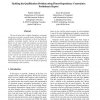Free Online Productivity Tools
i2Speak
i2Symbol
i2OCR
iTex2Img
iWeb2Print
iWeb2Shot
i2Type
iPdf2Split
iPdf2Merge
i2Bopomofo
i2Arabic
i2Style
i2Image
i2PDF
iLatex2Rtf
Sci2ools
TIME
1998
IEEE
1998
IEEE
Tackling the Qualification Problem using Fluent Dependency Constraints: Preliminary Report
The use of causal rules or fluent dependency constraints has proven to provide a versatile means of dealing with the ramification problem. In this paper we show how fluent dependency constraints together with the use of durational fluents can be used to deal with problems associated with action qualification. We provide both a weak and strong form of qualification and demonstrate the approach using an action scenario which combines solutions to the frame, ramification and qualification problems in the context of actions with duration, concurrent actions, non-deterministic actions and the use of both boolean and non-boolean fluents. The circumscription policy used for the combined problems is reducible to the 1st-order case. In addition, we demonstrate the use of a research tool VITAL, for querying and visualizing action scenarios.
Action Scenarios | Automated Reasoning | Durational Fluents | Fluent Dependency Constraints | TIME 1998 |
| Added | 05 Aug 2010 |
| Updated | 05 Aug 2010 |
| Type | Conference |
| Year | 1998 |
| Where | TIME |
| Authors | Patrick Doherty, Jonas Kvarnström |
Comments (0)

